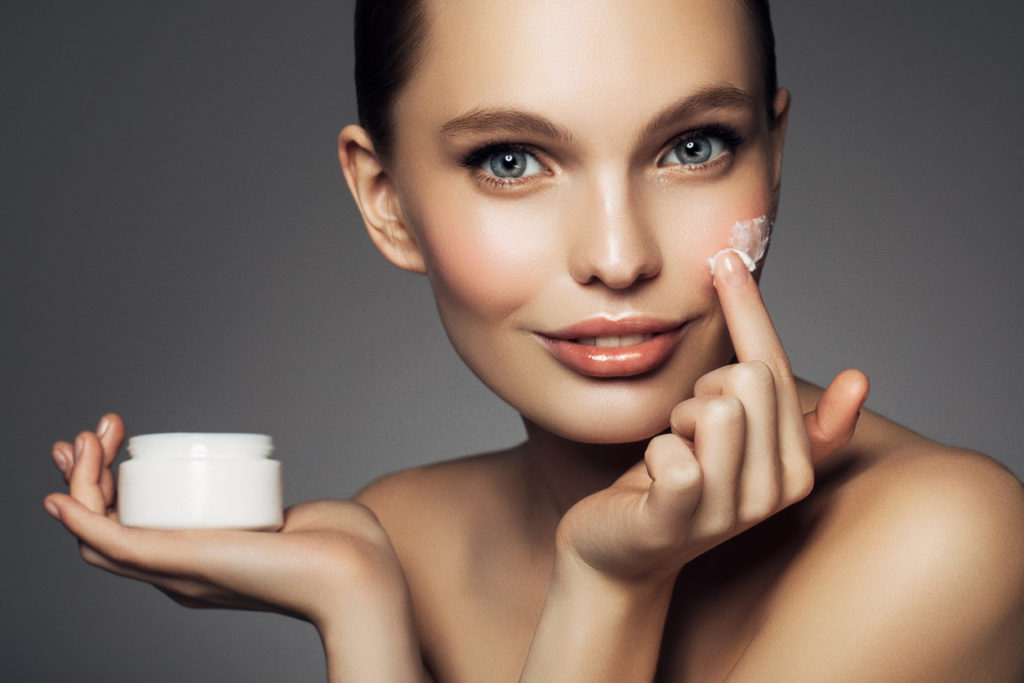In partnership with SA’s top medical aesthetic companies
Your skin is made up of three main sections. Certain skin care products won’t be absorbed below the most superficial layer of the skin. Cosmeceuticals, on the other hand, go much deeper into the skin, allowing for more noticeable changes – from clearing acne, plumping the skin and reducing the appearance of ageing.
Dr Albert Kligman coined the term cosmeceutical in the early 1980s to describe the marriage between cosmetics and pharmaceuticals. Adding cosmeceuticals to your skincare regime can target problem areas or concerns with noticeable changes. These products have a much higher concentration of active ingredients that go deeper into the skin.
How it works
Let’s take a look at the three main sections that make up your skin.

Epidermis
This is the top layer, i.e. the part of the skin you can see. The thinnest layer is found on your eyelids and thickest on the soles of your feet. The epidermis is responsible for making new skin cells. They’re made at the bottom of this layer from where they travel up to the top, where old skin cells flake off. This entire process takes 28 days. The epidermis also makes melanin, which is what gives your skin its colour.
The epidermis is a physical layer of protection from irritants, trauma and infections. Any cracks, dryness or breaks in the epidermis lead to skin inflammation. A fantastic product for barrier repair is the Gentle Rejuvenation System by Obagi.
Retinol is a chemical derived from Vitamin A. It has been found to be very effective in regulating the turnover of cells in the epidermis. Previously retinoids were only used to treat acne. Subsequent research has shown that retinol can speed up skin turnover, removing skin blemishes and pigmentation. Try Skin Ceuticals Retinol 1.0 serum for a retinol boost.
Glycolic acid is an ingredient that could be included in a skin peel. Glycolic peels such as NeoStrata’s 20% Glycolic can help with the absorption of active ingredients – and it’s a myth that they thin out your skin. Peels in fact thin out the stratum corneum, the topmost layer of dead skin cells, allowing active ingredients to penetrate deeper into the skin.
Did you know? You can help prevent wrinkles on your face by delicately caring for your skin. Use proper eye make-up remover to avoid scrubbing thedelicate skin around your eyes.
Dermis
The second layer is called the dermis and has multiple important tasks. The dermis has sweat glands to make sweat, and help regulate body temperature. This layer also allows for sensation as nerve endings that send signals to your brain are found here.
Glands in the dermis make oil to keep your skin feeling soft and looking smooth. When too much oil is produced, you may find yourself getting acne. Glands in the dermis make oil to keep your skin feeling soft and looking smooth.
When too much oil is produced, you may find yourself getting acne. Lamelle’s Clarity range is a good product when looking for something to keep pores unblocked and your texture refined.
The dermis contains all the blood vessels that supply the skin with nutrients, vitamins and minerals. Vessels also allow infection fighting cells to reach the skin. In many ways the dermis forms part of the immune system.
The dermis is where you will find collagen, elastin and hyaluronic acid. These are the substances that give your skin a plump, firm texture. Losing these as we age is one of the main reasons for wrinkles and lax skin. It’s for this reason we inject hyaluronic acid in the form of dermal fillers into the skin, to regain that plumpness. The breaking down of dermal fillers in the skin over time also leads to stimulating new collagen and elastin production.
You can stimulate the growth of collagen at a molecular level by using peptides. Peptides are small proteins. They can both stimulate collagen growth as well as being the building blocks for collagen. Peptides are tiny and able to penetrate through the epidermis to the dermis where they are needed. Try Dermaquest, which contains a combination of peptides, alpha hydroxy acids and super antioxidants.
Did you know? Your skin is home to billions of bacteria. The normal “flora” of the skin helps to fight off harmful infections. Using antibacterial soaps can be harmful to your skin’s regular flora. Always use gentle skincare products.
Subcutaneous fat
The last layer attaches your dermis to your muscles and bones. It helps control your body temperature because it stores fat, which pads and protects your body. One of the most annoying problems of subcutaneous fat is cellulite – when small pockets of this fat penetrate through the collagen, giving the skin a bumpy appearance.
References:
https://www.aad.org/public/kids/skin/the-layers-of-your-skin
http://www.skinonline.co.za/; http://thedermblog.com/2008/06/23/do-peptides-in-skin-care-products-work/
http://www.thedermreview.com/peptides-for-skin/
http://www.advancedskinbeauty.com.au/blog/what-are-cosmeceuticals-and-how-do-they-work/
